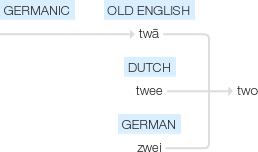Two
Old English twā (feminine and neuter) of Germanic origin; related to Dutch twee and German zwei, from an Indo-European root shared by Latin and Greek duo . Compare with twain.
wiktionary
From Middle English two, twa, from Old English twā, neuter of twēġen (whence twain), from Proto-West Germanic *twai-, from Proto-Germanic *twai, from Proto-Indo-European *dwóh₁.
Cognate with Scots twa(“two”); North Frisian tou, tuu(“two”); Saterland Frisian twäin, two(“two”); West Frisian twa(“two”); Dutch twee(“two”); Low German twee, twei(“two”); German zwei, zwo(“two”); Danish and Norwegian to(“two”); Swedish två, tu(“two”); Icelandic tvö(“two”); Latin duō(“two”); Ancient Greek δύο(dúo, “two”); Irish dhá(“two”); Lithuanian dù(“two”); Russian два(dva, “two”); Albanian dy(“two”); Old Armenian երկու(erku, “two”); Sanskrit द्व(dvá, “two”); Tocharian A wu, Tocharian B wi. Doublet of duo. See also twain.
etymonline
two (adj., n.)
"1 more than one, the number which is one more than one; a symbol representing this number;" Old English twa "two," fem. and neuter form of twegen "two" (see twain), from Proto-Germanic *twa (source also of Old Saxon and Old Frisian twene, twa, Old Norse tveir, tvau, Dutch twee, Old High German zwene, zwo, German zwei, Gothic twai), from PIE *duwo, variant of root *dwo- "two."
Two-fisted is from 1774. Two cheers for _____, expressing qualified enthusiasm first recorded 1951 in E.M. Forster's title "Two Cheers for Democracy." Two-dimensional is recorded from 1883; figurative sense of "lacking substance or depth" is attested from 1934.
